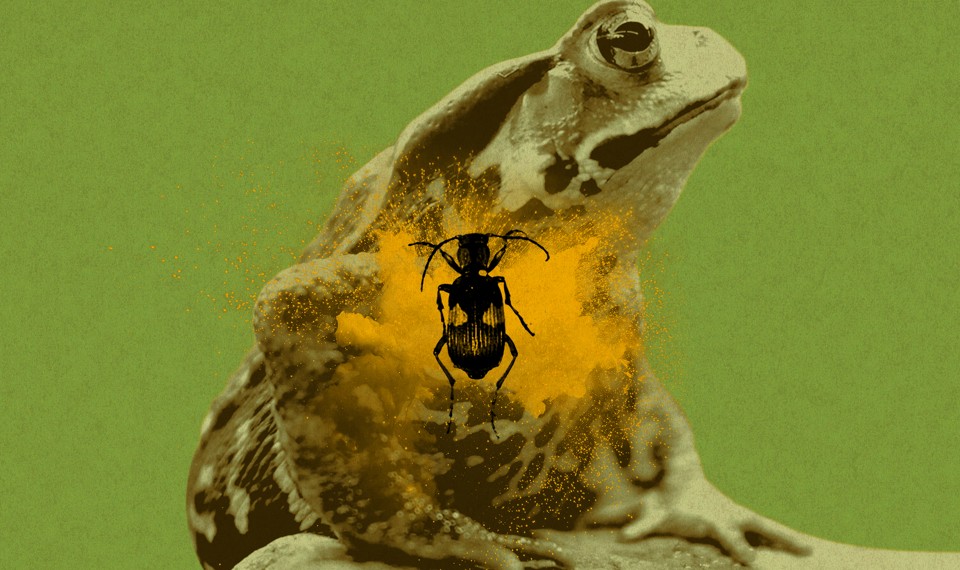The Ed's Up #214

I Spent Two Years Trying to Fix the Gender Imbalance in My Stories
"I found that ratio in my work, too. Shortly after Adrienne published her analysis, I looked back at the pieces that I had published in 2016 thus far. Across all 23 of them, 24 percent of the quoted sources were women. And of those stories, 35 percent featured no female voices at all. That surprised me. I knew it wasn’t going to be 50 percent, but I didn’t think it would be that low, either. I knew that I care about equality, so I deluded myself into thinking that I wasn’t part of the problem. I assumed that my passive concern would be enough. Passive concern never is. I’ve since been trying to actively redress the balance." (Image: Hinterhaus Productions)

How to Survive Being Swallowed by Another Animal
"Bombarder beetles are named for their ability to spray scalding, caustic liquid from their backsides. They do so by mixing chemicals housed in two separate glands. Separately, these substances are inert. Together, they react with explosive results. The beetles can create around 500 of these explosions every second, creating chemical streams that reach over 100 degrees Celsius and travel at up to 22 miles per hour. That’s enough to ward off most predators. But toads can project their sticky tongues so quickly that they can snag a bombardier beetle before it gets a chance to unleash hell. That’s certainly what Shinji Sugiura and Takuya Sato from Kobe University saw when they put the two animals together. The toads would swallow the beetles. “However,” the duo write, “an explosion was audible inside each toad.” And also, like, in my mind." (Image: Ear lew boo / Michael Zduniak) 
What Scientists Learned From Putting 3-D Glasses on Praying Mantises
"Praying mantises spend most of their lives being still. But to put 3-D glasses on these insects, Vivek Nityananda had to get them to stay really still. He would put their cages in a freezer for five minutes, to quite literally chill them out, before sticking their legs down with tiny blobs of Plasticine. He then put a little drop of beeswax between their eyes, and pushed two tear-shaped colored filters into the wax. These bespoke glasses allowed Nityananda and his colleagues to show a different image to each of the mantis’s bulbous eyes. And by doing that, he showed that these animals have a unique kind of stereovision. “It’s a completely different mechanism than what we’ve seen in any other animal,” Nityananda says." (Image: Newcastle University)

The Horror of a World Without Microbes
"In 2014, the microbiologists Jack Gilbert and Josh Neufeld published a thought experiment, in which they imagined what would happen if all the microbes in the world suddenly vanished. It’s a fun essay that draws upon two long-standing scientific traditions: working out how important things are by removing them and seeing what happens; and just using your imagination if actual experiments aren’t feasible." (Image: Pichi Chuang)Friends of the Ed's Up
Here's where I promote the work of people I care about--people who make incredible art that I think is worthy of your attention and support, but whose fierce intelligence is also match by a genuine warmth of spirit.Story Collider features true personal stories about science. In the latest episode of the podcast, rattled by a recent heartbreak, neuroscientist Prabarna Ganguly makes a mistake in the lab, and marine ecologist Kirsten Grorud-Colvert has an unexpected encounter with a hammerhead shark. Directors Liz Neeley and Erin Barker also run workshops teaching storytelling skills to scientists. And there are live shows coming up in DC (Feb 22), Granville(Feb 28), NYC (Mar 6), St Louis (Mar 7), and Atlanta (Mar 12).
Flash Forward is a podcast about the future run by Rose Eveleth. It's part radio drama, part science journalism, and a lot of fun. The latest episode is a retrospective on the amazing third season.
Gastropod is a food, science, and history podcast run by Cynthia Graber and Nicola Twilley. The latest episode is on dieting.
The Brain Scoop is a video show about natural history, museums, and occasionally taxidermy, hosted by Emily Graslie. The latest episode is about the art of discovering new species.
More good reads
- The National Science Foundation announced a new, long-overdue policy to crack down on sexual harassment—but women scientists argue that it’s far from enough. Emily Atkin reports.
- "The FBI is slowly becoming the tool of partisan warfare that its defenders claim it must never be.” By Adam Serwer.
- A pet crayfish can clone itself and it’s slowly spreading around the globe. Sarah Zhang has the story.
- The awesome Liz Neeley has curated a group of six conservation papers, in which scientists tell personal stories from the frontline, but with the rigor of peer review. I'd love to see much more of this. I’m especially singling out Nick Haddad’s beautiful story about resilience and resurrection in the world’s rarest butterflies, and Karen Lips on the horror of witnessing extinction in real-time.
- Elon Musk sent a car into space. Marina Koren has written a tryptich of insightful pieces on the launch, the symbolism of the car, and, er, where that car is actually headed.
- “The Republican Party, as an institution, has become a danger to the rule of law and the integrity of our democracy,” says Benjamin Wittes and Jonathan Rauch.
You can also follow me on Twitter or find my writing at The Atlantic. My New York Times-bestselling book, I Contain Multitudes, is out now. If someone has forwarded this email to you, you can sign up yourself.
And that's it. Thanks for reading.
- Ed